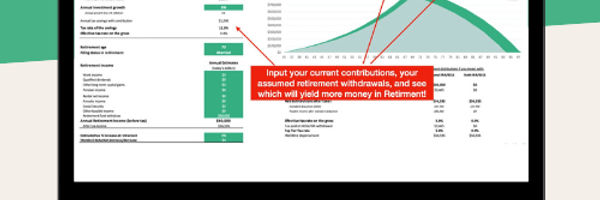In this article, we're going to discuss IRA rollovers. We'll start off by briefly explaining why an IRA rollover might be necessary, as well as providing a definition of the term. We're then going to talk about the difference between a rollover and a transfer, and finish up with some of the rules that can help individuals avoid income tax penalties.

Roth IRA or 401k? This template will answer your questions.
With this template, you will get:
All DFY, simply add your details
Charts for comparison and clear answer
Easily update for any year (2023, 2024, 2025, etc…)

What is an IRA Rollover?
Lifetime employment is an outdated concept. That being said, there are two future mindsets everyone can be certain of:
They will reach a point where retirement planning becomes a priority.
There is a good chance that workers will not finish their careers with the same employer that they started with.
Some companies will allow employees to keep their retirement savings in their plan's account until they reach retirement age, even if they leave the company. But, there is a very good chance some flexibility will be lost in terms of how that money is invested after leaving. The account might go from one that can be actively managed, to one that is "frozen" with respect to the allocation of funds between asset types. Individuals may also wish to consolidate their retirement plans, so they don't need to worry about managing several accounts. If that's true, then one day they may need to make a decision concerning an IRA rollover.
Rollover Definition
A rollover is a tax-free distribution from one retirement account that is contributed to an IRA. There are several kinds of retirement accounts that can be rolled-over into a Traditional IRA, including another Traditional IRA, an employer's qualified plan such as a 401(k) plan, deferred compensation plans (section 457 plan), and a tax-sheltered annuity plan such as a 403(b). Employees should always check with their plan administrator to make sure they can perform a rollover from their account.
Rollovers versus Transfers
There are two ways of moving money between financial institutions: performing a transfer, or doing a rollover. Most of the time, it is far easier to do a transfer than a rollover, especially if an existing plan will accommodate the request. With a transfer, it's necessary to make arrangements with another financial institution to receive funds from the current institution. The receiving institution then sends a request to the disbursing institution to transfer funds. This is usually accomplished via a physical check.
IRA rollovers allow individuals to consolidate their retirement plans, so they don't need to worry about managing several accountsMoneyzine Editor
This type of transaction does not have to be reported to the IRS, and requires very little work on behalf of the accountholder's part. Transfers are sometimes referred to as direct rollovers, and are not subject to the 20% IRS withholding tax, which will be discussed later on. With a rollover, the retirement funds are distributed from the disbursing institution directly to the former accountholder. This means a check is sent directly to an individual, not a financial institution. Unlike a transfer, a rollover is reported to the IRS. This is to ensure that the individual receiving the money abides by the rollover rules, and deposits the money into another qualifying retirement account in a timely manner.
60-Day Rollover Rule
In general, individuals have 60 days to complete a rollover after receiving the distribution from their Traditional IRA or an employer's qualifying plan such as a 401(k) or 403(b). The IRS might waive the 60-day requirement if it can be demonstrated that a significant hardship or event occurred that was beyond control. Individuals that wish to obtain a waiver must complete a request for a ruling and an application fee may apply.
Extensions
Individuals can qualify for an extension of the 60-day rule if the deposit becomes frozen at any time during the 60 days. There are two specific rules that extend the rollover timeline. Both of these have to do with frozen deposits: money that is held by banks that have become insolvent or bankrupt. If the distribution becomes a frozen deposit, then the time during which the money is frozen does not count towards the 60-day timeframe. Also, the 60 days cannot expire less than 10 days after the deposit is no longer frozen.
IRS Withholding
If an eligible rollover is paid directly to an individual, then the distribution may be subject to 20% withholding. This rule applies even if the intention is to roll the money into a Traditional IRA. To avoid any tax penalties, individuals need to rollover 100% of the money withdrawn into the receiving account.
Withholding Example
Let's take a closer look at this withholding rule. Let's say that Joe has $10,000 in an account that he wants to rollover to a new retirement account. If the money is sent directly to Joe, then he'll receive $8,000 (20% will be withheld). To avoid any tax penalties, he will have to send $10,000 to the receiving account. That means Joe needs to make sure he has access to funds to make up for the 20% withheld. In this example, that amount is $2,000. Individuals can avoid the 20% withholding by having the distribution set up as a direct rollover, or transfer, as mentioned above. This means the money goes directly from the withdrawal account to the receiving account. Retirement plan administrators provide this service all the time, and they can help walk accountholders through the process.
Future Contributions
There are some benefits of keeping a rollover IRA separate from any other IRAs that have been funded in the past, or that would be funded in the future. That's because once a personal contribution is made to an account that was part of a rollover, the ability to move that account to a new company's sponsored plan may be lost.
Rollover IRA Withdrawal Rules
The withdrawal rules for a rollover IRA are exactly the same as the rules for a Traditional IRA. The contributions and earnings are taxed when withdrawn after age 59 1/2. Any withdrawals before the age 59 1/2 are taxable and subject to an additional 10% tax penalty. Mandatory withdrawals from a rollover IRA begin the year after an individual reaches age 70 1/2. For more information on these types of distributions, including allowed exceptions to these rules, see our article: IRA Withdrawals.
Roth IRA Rollovers
Finally, we'd like to mention there is no such thing as a Roth IRA rollover. That's because the IRS refers to the process of rolling-over a Traditional IRA to a Roth IRA a conversion. There are worksheets involved to figure out if a taxpayer qualifies; there are tax and withholding implications too. This subject is best discussed with a tax professional. Ambitious readers can take a look at the 100-page publication by the IRS - Publication 590, which thoroughly discusses the topic of IRA conversions.


